网站做推广的方式google推广 的效果

✅作者简介:大家好,我是橘橙黄又青,一个想要与大家共同进步的男人😉😉
🍎个人主页:橘橙黄又青-CSDN博客
1.🍎链表的分类
前面我们学过顺序表,顺序表问题:
- 1. 中间/头部的插入删除,时间复杂度为O(N)
- 2. 增容需要申请新空间,拷贝数据,释放旧空间。会有不小的消耗。
- 3. 增容一般是呈2倍的增长,势必会有一定的空间浪费。例如当前容量为100,满了以后增容到 200,我们再继续插入了5个数据,后面没有数据插入了,那么就浪费了95个数据空间。
这些问题,链表给出了相应的答案。
概念:链表是一种物理存储结构上非连续、非顺序的存储结构,数据元素的逻辑顺序是通过链表 中的指针链接次序实现的 。
比如说我们前面学习的单链表就是如此。
单链表是单向不循环不带头链表

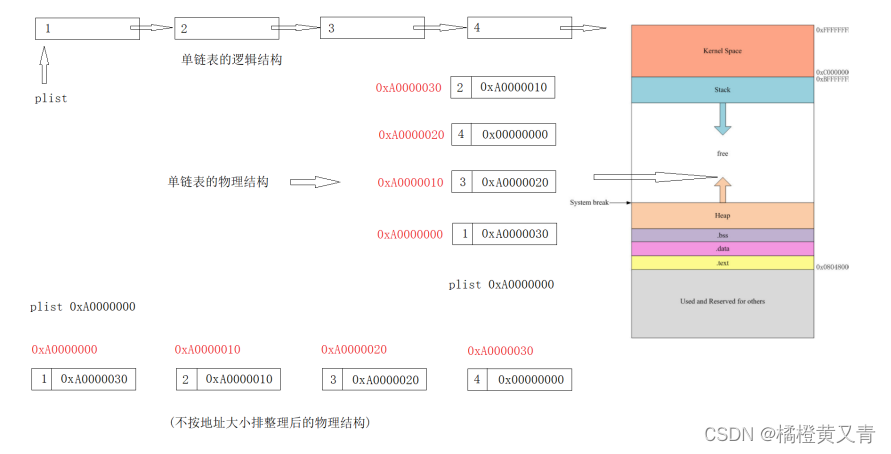
实际中要实现的链表的结构非常多样,以下情况组合起来就有8种链表结构:
- 1. 单向、双向
- 2. 带头、不带头
- 3. 循环、非循环
又称2x2x2
图解:
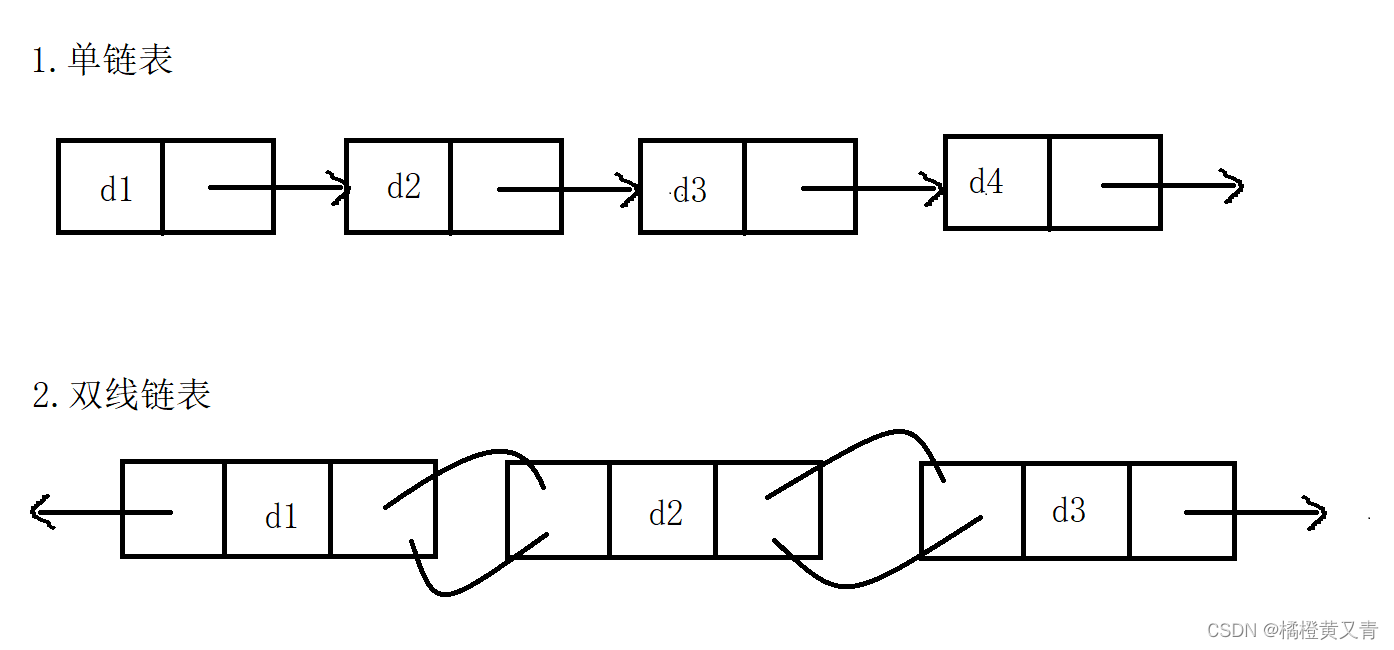
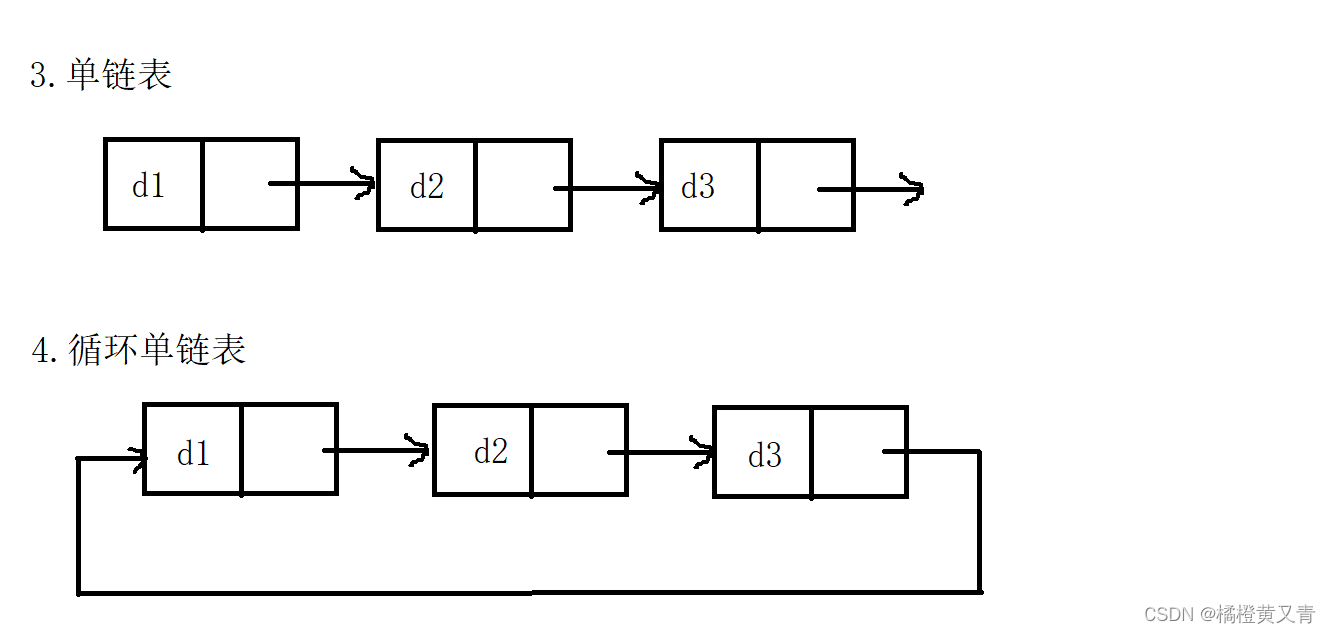

- 1. 无头单向非循环链表:结构简单,一般不会单独用来存数据。实际中更多是作为其他数据结 构的子结构,如哈希桶、图的邻接表等等。另外这种结构在笔试面试中出现很多。
- 2. 带头双向循环链表:结构最复杂,一般用在单独存储数据。实际中使用的链表数据结构,都 是带头双向循环链表。另外这个结构虽然结构复杂,但是使用代码实现以后会发现结构会带 来很多优势,实现反而简单了,后面我们代码实现了就知道了。
2.🍎链表相关基础oj
| 题目 | 链接 |
|---|---|
| 设计链表 | . - 力扣(LeetCode) |
| 两数相加 | . - 力扣(LeetCode) |
| 合并两个有序链表 | . - 力扣(LeetCode) |
| 两两交换链表中的节点 | . - 力扣(LeetCode) |
| 删除排序链表中的重复元素 | . - 力扣(LeetCode) |
| 删除排序链表中的重复元素II | . - 力扣(LeetCode) |
| 相交链表 | . - 力扣(LeetCode) |
| 移除链表元素 | . - 力扣(LeetCode) |
| 回文链表 | . - 力扣(LeetCode) |
| 奇偶链表 | . - 力扣(LeetCode) |
| 链表的中间结点 | . - 力扣(LeetCode) |
| 链表最大孪生和 | . - 力扣(LeetCode) |
| 两两交换链表中的节点 | 404: This page could not be found |
合并两个链表中,可以安排一个哨兵(头)可以减少判断空的代码。
哨兵位的申请:

这些都是比较好的题目,
接下来我们分析几道题目
| 题目 | 链接 |
|---|---|
| 反转链表 | . - 力扣(LeetCode) |
| 反转链表II | . - 力扣(LeetCode) |
| 链表中间节点问题 | . - 力扣(LeetCode) |
| 环形链表的约瑟夫问题 | 环形链表的约瑟夫问题_牛客题霸_牛客网 |
2.1🍎第一个反转链表
第一种:头插法
/*** Definition for singly-linked list.* struct ListNode {* int val;* struct ListNode *next;* };*///头插术
typedef struct ListNode ListNode;
struct ListNode* reverseList(struct ListNode* head) {ListNode* returnHead = NULL;ListNode* ListLt = head;while(ListLt != NULL){//保存下一个节点ListNode* temp = ListLt -> next;//换头手术ListLt -> next = returnHead;returnHead = ListLt;//迭代ListLt = temp;}return returnHead;
}这里说一个错误代码:
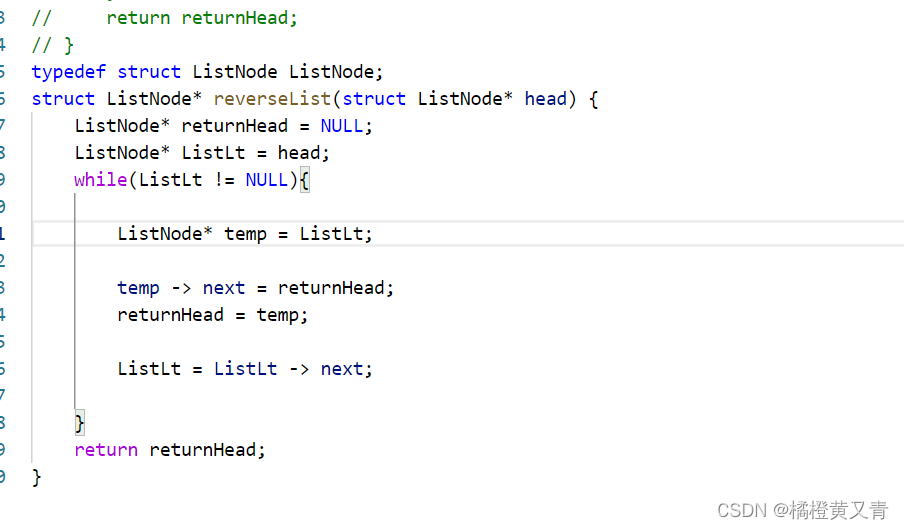
输出结果为1,为什么来:
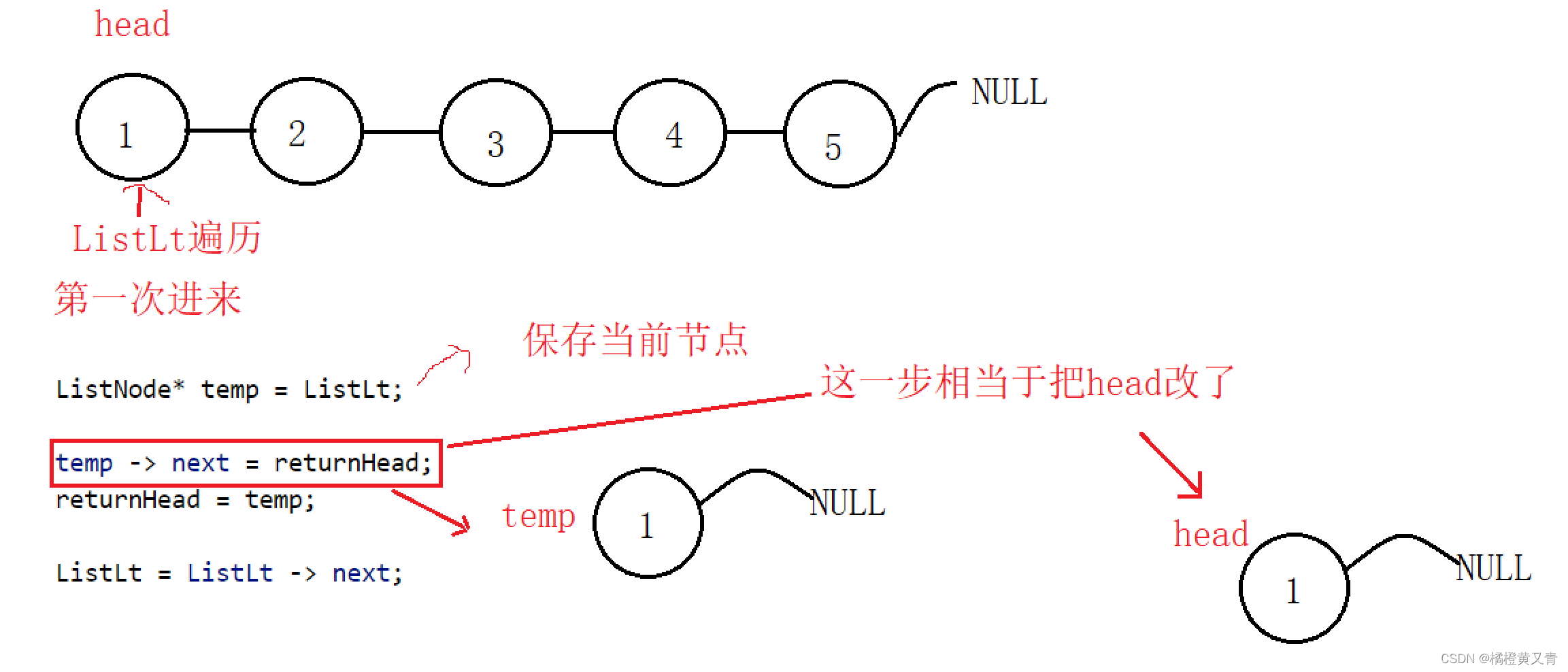
所以temp要保存下一个节点。
第二种解法:
三指针法:
代码:
/*** Definition for singly-linked list.* struct ListNode {* int val;* struct ListNode *next;* };*/typedef struct ListNode ListNode;
struct ListNode* reverseList(struct ListNode* head) {if(head == NULL){return head;}ListNode* n1 = NULL;ListNode* n2 = head;ListNode* n3 = head -> next;ListNode* pcur = head;while(n2){n2-> next = n1;n1 = n2;n2 = n3;if(n3){//这里防止n3为空,如果为空就无nextn3 = n3 -> next; }}return n1;
}图解:

链表II与这个差不多,思路更为复杂。
2.2🍎链表中间节点问题
可以遍历链表计数除2,也可以使用双指针法
双指针法:
思路:
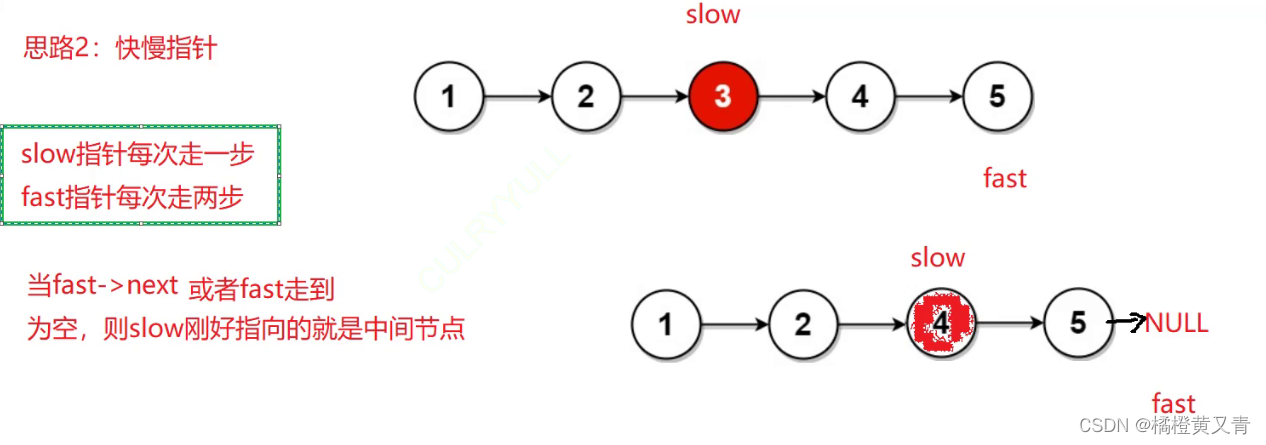 代码:
代码:
/*** Definition for singly-linked list.* struct ListNode {* int val;* struct ListNode *next;* };*/typedef struct ListNode ListNode;
struct ListNode* middleNode(struct ListNode* head) {ListNode* slow,*fast;slow = fast = head;while(fast && fast -> next){slow = slow -> next;fast = fast -> next -> next;}return slow;
}值得注意的是循环条件不能写成 fast -> next &&fast ,原因是计算机编译器是从左往右编译的,如果fast为空,就没有fast -> next。
快慢指针法以后会经常使用务必理解.
2.3.环形链表的约瑟夫问题
题目:
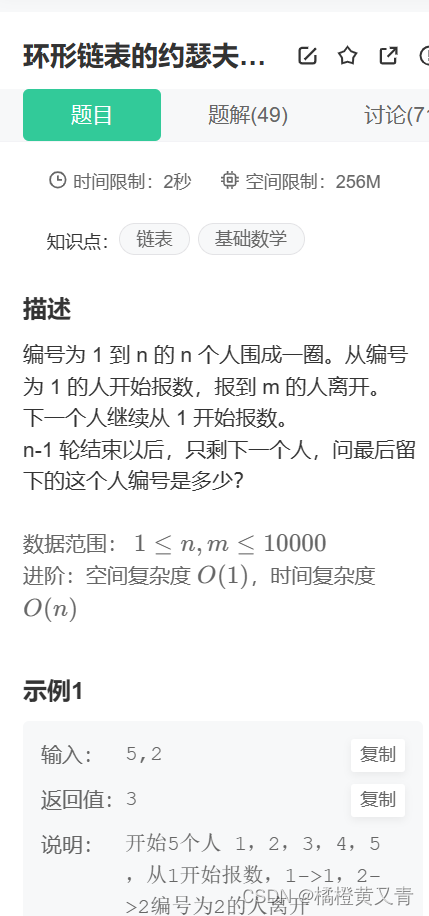
这里我们输入Li 它就有暗示,说明已经有结构体结构了
解题代码:
/*** 代码中的类名、方法名、参数名已经指定,请勿修改,直接返回方法规定的值即可** * @param n int整型 * @param m int整型 * @return int整型*/typedef struct ListNode ListNode;
//申请一个节点ListNode* BuyNode(int x){ListNode* newNode = (ListNode*)malloc(sizeof(ListNode));newNode -> val = x;newNode -> next = NULL;return newNode;}ListNode* creteList(int n){ListNode* phead = BuyNode(1);ListNode* ptail = phead;//创建链表和标号for (int i = 2; i <= n; i++) {ptail -> next = BuyNode(i);ptail = ptail -> next;}//链表首尾链接ptail -> next = phead;return phead;}
#include <stdio.h>
int ysf(int n, int m ) {//逢m删除节点ListNode* head = creteList(n);ListNode* pcur = head;//前驱节点ListNode* prev = NULL;int conut = 1;while (pcur ->next != pcur) {if(conut == m){//删除当前节点prev -> next = pcur ->next;free(pcur);//删除节点后往后走,让pcur走到新的位置,conut为初始值pcur = prev -> next;conut = 1;}else{//pcur往后走prev = pcur;pcur = pcur -> next;conut++;}}//此时pcur节点就是活下来的节点return pcur -> val;
}3.🍎上节链表代码建议重复观看
SList.c文件:

SList.h文件
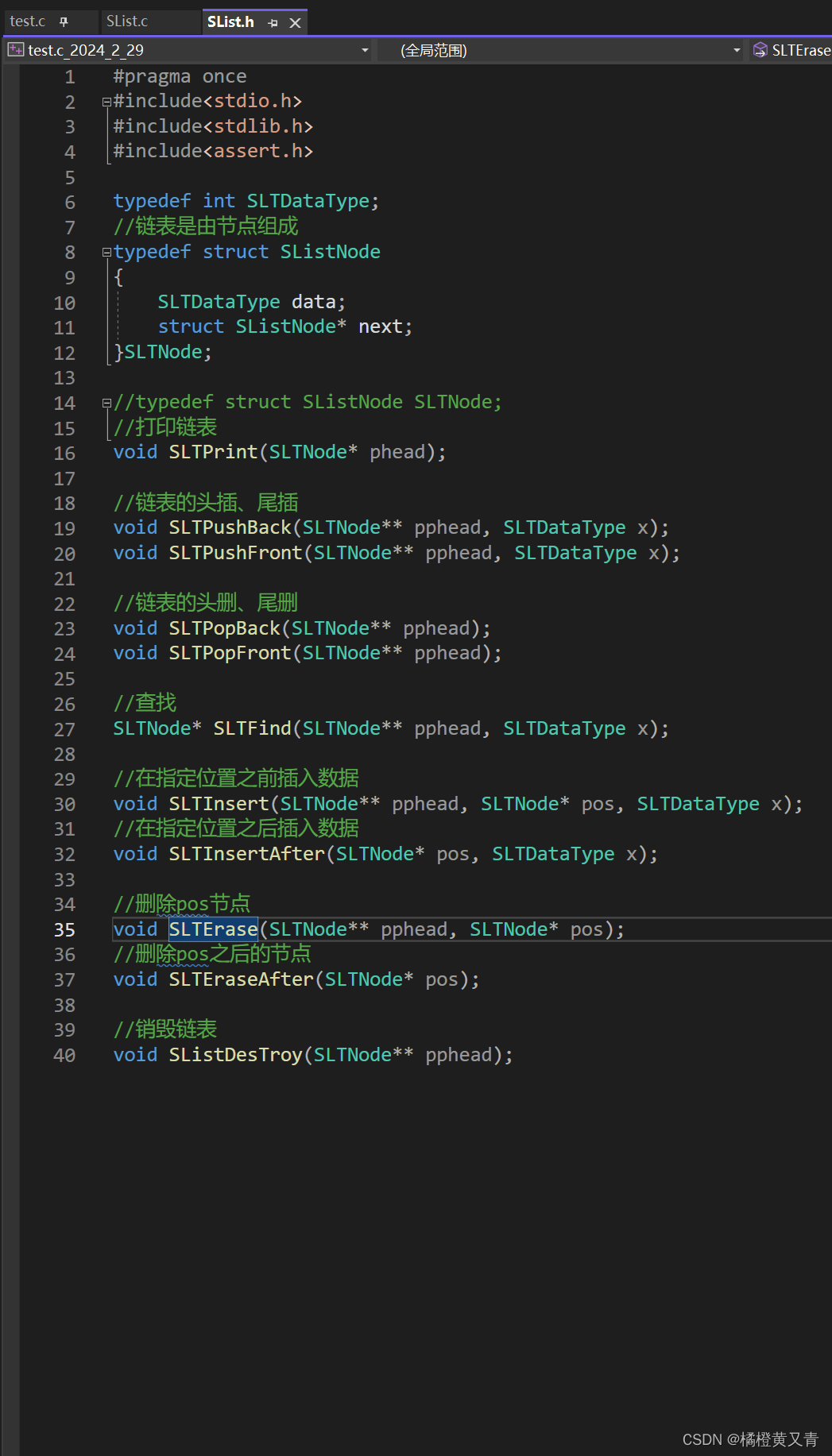
test.c文件测试代码:
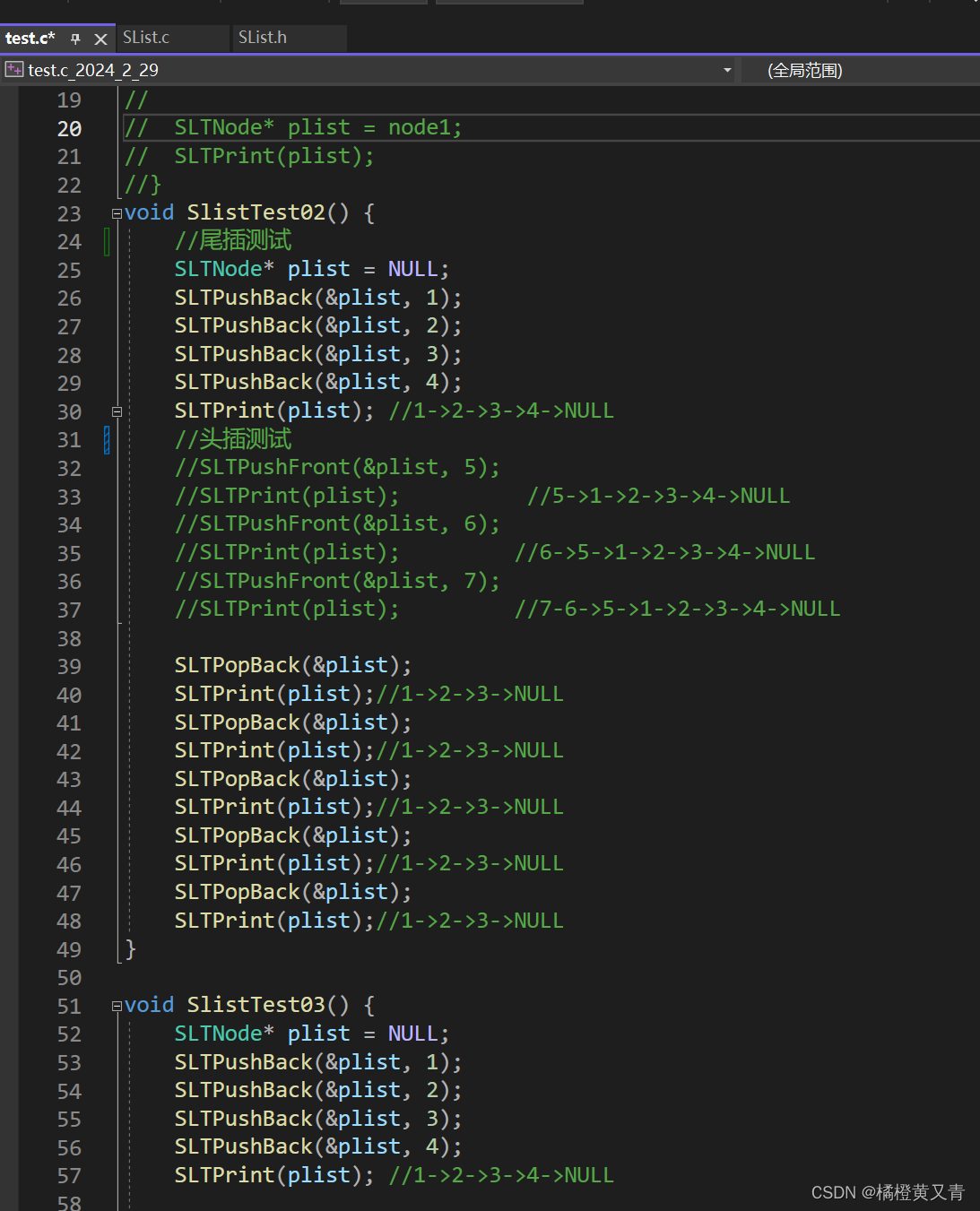
test.c文件代码
#include"SList.h"//void SlistTest01() {
//
// 链表的打印
// SLTNode* node1 = (SLTNode*)malloc(sizeof(SLTNode));
// node1->data = 1;
// SLTNode* node2 = (SLTNode*)malloc(sizeof(SLTNode));
// node2->data = 2;
// SLTNode* node3 = (SLTNode*)malloc(sizeof(SLTNode));
// node3->data = 3;
// SLTNode* node4 = (SLTNode*)malloc(sizeof(SLTNode));
// node4->data = 4;
//
// node1->next = node2;
// node2->next = node3;
// node3->next = node4;
// node4->next = NULL;
//
// SLTNode* plist = node1;
// SLTPrint(plist);
//}
void SlistTest02() {//尾插测试SLTNode* plist = NULL;SLTPushBack(&plist, 1);SLTPushBack(&plist, 2);SLTPushBack(&plist, 3);SLTPushBack(&plist, 4);SLTPrint(plist); //1->2->3->4->NULL//头插测试//SLTPushFront(&plist, 5);//SLTPrint(plist); //5->1->2->3->4->NULL//SLTPushFront(&plist, 6);//SLTPrint(plist); //6->5->1->2->3->4->NULL//SLTPushFront(&plist, 7);//SLTPrint(plist); //7-6->5->1->2->3->4->NULLSLTPopBack(&plist);SLTPrint(plist);//1->2->3->NULLSLTPopBack(&plist);SLTPrint(plist);//1->2->3->NULLSLTPopBack(&plist);SLTPrint(plist);//1->2->3->NULLSLTPopBack(&plist);SLTPrint(plist);//1->2->3->NULLSLTPopBack(&plist);SLTPrint(plist);//1->2->3->NULL
}void SlistTest03() {SLTNode* plist = NULL;SLTPushBack(&plist, 1);SLTPushBack(&plist, 2);SLTPushBack(&plist, 3);SLTPushBack(&plist, 4);SLTPrint(plist); //1->2->3->4->NULLSListDesTroy(&plist);头删//SLTPopFront(&plist);//SLTPrint(plist); //2->3->4->NULL//SLTPopFront(&plist);//SLTPrint(plist); //3->4->NULL//SLTPopFront(&plist);//SLTPrint(plist); //4->NULL//SLTPopFront(&plist);//SLTPrint(plist); //NULL//SLTPopFront(&plist);//SLTPrint(plist); //assert//查找测试//SLTNode* FindRet = SLTFind(&plist, 3);//if (FindRet) {// printf("找到了!\n");//}//else {// printf("未找到!\n");//}//SLTInsert(&plist, FindRet, 100);//SLTInsertAfter(FindRet, 100);//删除指定位置的节点测试//SLTErase(&plist, FindRet);//SLTPrint(plist); //1->2->3->NULL
}
int main() {//SlistTest01();//SlistTest02();SlistTest03();return 0;
}SList.c文件代码:
#include"SList.h"
//打印
void SLTPrint(SLTNode* phead) {SLTNode* pcur = phead;while (pcur){printf("%d->", pcur->data);pcur = pcur->next;}printf("NULL\n");
}
//开辟空间
SLTNode* SLTBuyNode(SLTDataType x) {SLTNode* newnode = (SLTNode*)malloc(sizeof(SLTNode));if (newnode == NULL) {perror("malloc fail!");exit(1);}newnode->data = x;newnode->next = NULL;return newnode;
}
//
void SLTPushBack(SLTNode** pphead, SLTDataType x) {assert(pphead);//开辟空间SLTNode* newnode = SLTBuyNode(x);//链表为空,新节点作为pheadif (*pphead == NULL) {*pphead = newnode;return;}//链表不为空,找尾节点SLTNode* ptail = *pphead;while (ptail->next){ptail = ptail->next;}//ptail就是尾节点ptail->next = newnode;
}
//头插
void SLTPushFront(SLTNode** pphead, SLTDataType x) {assert(pphead);SLTNode* newnode = SLTBuyNode(x);//newnode *ppheadnewnode->next = *pphead;*pphead = newnode;
}
//尾删
void SLTPopBack(SLTNode** pphead) {assert(pphead);//链表不能为空assert(*pphead);//链表不为空//链表只有一个节点,有多个节点if ((*pphead)->next == NULL) {free(*pphead);*pphead = NULL;return;}SLTNode* ptail = *pphead;SLTNode* prev = NULL;while (ptail->next){prev = ptail;ptail = ptail->next;}prev->next = NULL;//销毁尾结点free(ptail);ptail = NULL;
}
//头删
void SLTPopFront(SLTNode** pphead) {assert(pphead);//链表不能为空assert(*pphead);//让第二个节点成为新的头//把旧的头结点释放掉SLTNode* next = (*pphead)->next;free(*pphead);*pphead = next;
}
//查找
SLTNode* SLTFind(SLTNode** pphead, SLTDataType x) {assert(pphead);//遍历链表SLTNode* pcur = *pphead;while (pcur) //等价于pcur != NULL{if (pcur->data == x) {return pcur;}pcur = pcur->next;}//没有找到return NULL;
}
//在指定位置之前插入数据
void SLTInsert(SLTNode** pphead, SLTNode* pos, SLTDataType x) {assert(pphead);assert(pos);//要加上链表不能为空assert(*pphead);SLTNode* newnode = SLTBuyNode(x);//pos刚好是头结点if (pos == *pphead) {//头插SLTPushFront(pphead, x);return;}//pos不是头结点的情况SLTNode* prev = *pphead;while (prev->next != pos){prev = prev->next;}//prev -> newnode -> posprev->next = newnode;newnode->next = pos;
}
//在指定位置之后插入数据
void SLTInsertAfter(SLTNode* pos, SLTDataType x) {assert(pos);SLTNode* newnode = SLTBuyNode(x);//pos newnode pos->nextnewnode->next = pos->next;pos->next = newnode;
}
//删除pos节点
void SLTErase(SLTNode** pphead, SLTNode* pos) {assert(pphead);assert(*pphead);assert(pos);//pos刚好是头结点,没有前驱节点,执行头删if (*pphead == pos) {//头删SLTPopFront(pphead);return;}SLTNode* prev = *pphead;while (prev->next != pos){prev = prev->next;}//prev pos pos->nextprev->next = pos->next;free(pos);pos = NULL;
}
//删除pos之后的节点
void SLTEraseAfter(SLTNode* pos) {assert(pos);//pos->next不能为空assert(pos->next);//pos pos->next pos->next->nextSLTNode* del = pos->next;pos->next = pos->next->next;free(del);del = NULL;
}
//销毁链表
void SListDesTroy(SLTNode** pphead) {assert(pphead);assert(*pphead);SLTNode* pcur = *pphead;while (pcur){SLTNode* next = pcur->next;free(pcur);pcur = next;}*pphead = NULL;
}SList.h文件代码:
#pragma once
#include<stdio.h>
#include<stdlib.h>
#include<assert.h>typedef int SLTDataType;
//链表是由节点组成
typedef struct SListNode
{SLTDataType data;struct SListNode* next;
}SLTNode;//typedef struct SListNode SLTNode;
//打印链表
void SLTPrint(SLTNode* phead);//链表的头插、尾插
void SLTPushBack(SLTNode** pphead, SLTDataType x);
void SLTPushFront(SLTNode** pphead, SLTDataType x);//链表的头删、尾删
void SLTPopBack(SLTNode** pphead);
void SLTPopFront(SLTNode** pphead);//查找
SLTNode* SLTFind(SLTNode** pphead, SLTDataType x);//在指定位置之前插入数据
void SLTInsert(SLTNode** pphead, SLTNode* pos, SLTDataType x);
//在指定位置之后插入数据
void SLTInsertAfter(SLTNode* pos, SLTDataType x);//删除pos节点
void SLTErase(SLTNode** pphead, SLTNode* pos);
//删除pos之后的节点
void SLTEraseAfter(SLTNode* pos);//销毁链表
void SListDesT今天就到这里了,都看到这里了,点一个赞吧,感谢观看。
